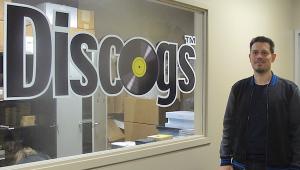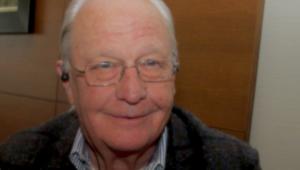If you are looking for a reliable casino with good bonuses, I recommend lucky star casino It has everything from classic slots to a live casino, as well as frequent promotions for active players. Registration takes a minute, and deposits are available in various ways. I've been playing for a long time, and so far I'm happy with everything!
Best Reissues of 2024: Art Alexakis on Why Intervention Records’ Truly Wonderful 140g 1LP Edition of Everclear’s Songs From an American Movie Vol. One: Learning How to Smile Sounds Exactly Like He Originally Intended
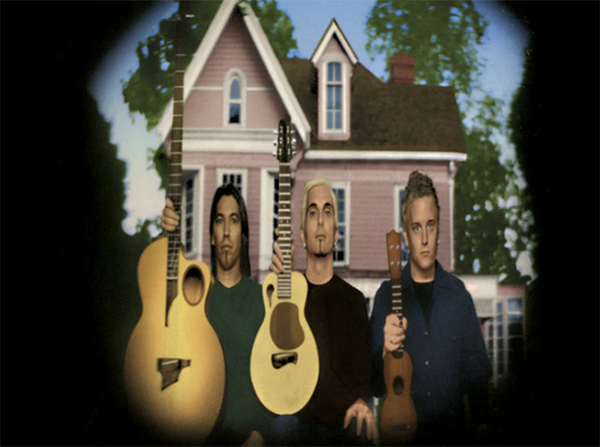
The 1990s were a decade of transition. It was a time when recording artists had to figure out how to move on from MTV-era preening and get back to creating their music more for aural satisfaction, not just visual pleasure. Everclear, an alt-rock trio from Portland, Oregon, made quite a splash during the ’90s — see “Santa Monica,” “Everything to Everyone,” and “Father of Mine,” for starters — but as the calendar turned to the 2000s, bandleader and chief songwriter Art Alexakis had a vision to chronicle how his life was falling apart, in two parts. The first half of that heart-wrenching story, July 2000’s Songs From an American Movie Vol. One: Learning How to Smile (Capitol), was a smash hit on CD, but it never made its way onto vinyl. Thankfully, Intervention Records righted that wrong back in September 2024 with their limited-edition 140g 1LP translucent yellow version of Vol. One, which is one of AP’s Best Reissues of 2024. Me, I give the Music an 8.5, and the Sound a 10 — and you’ll soon see why.
For starters, SFAAM Vol. One is “100%” analog mastered by Kevin Gray from the original master tapes — and you can read more about how that all came about here, in my initial News report that posted on June 4, 2024. Vol. One was initially released on 140g transparent yellow vinyl on September 13, 2024 (IR-035), in a limited edition of 2,000 copies and, as per usual with Intervention releases, the stampers are replaced every 500 units. (My copy is number 0097.) That run promptly sold out, so Intervention went back and repressed Vol. One on 140g Coke Bottle Clear vinyl in an “unlimited” edition that is currently available directly from the label here for $43, or from Music Direct for $44.99, via the MD link graphic at the end of this story.
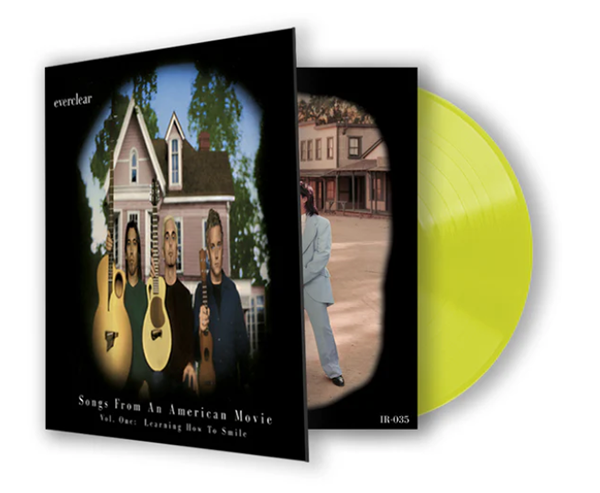
The road to getting Vol. One on vinyl wasn’t easy, mind you. “When that album came out in 2000, it was in our contract that Capitol had to put it out on vinyl, but then they said to me, they’re not going to do it!” Alexakis told me in an AP exclusive interview. “I’m talking to the president of the company, and he’s like, ‘Sue me.’ He’s laughing. And then he goes, ‘We’re selling CDs, and your album’s selling. It’s going to be great — but it’s not going to be on vinyl.’ So, almost 25 years later, I’m like, ‘Let’s just do it ourselves.’ We licensed it from Universal, who owns it. We’ve again used Intervention Records, the company that we’ve done our Sparkle and Fade and [So Much for the] Afterglow reissues with — and they did great, great versions of them.” (No argument here, as I also noted about those two fine IR reissues in my June 4 posting.)
To learn more about how this, er, wonderful development came to pass, I went directly to Intervention Records head honcho Shane Buettner to get his take on it. “I think Songs From an American Movie Vol. One is the ’90s version of Blood on the Tracks [Bob Dylan’s January 1975 masterpiece on Columbia],” Buettner believes. “It’s a beautiful and sometimes wrenching record about the sweet beginning, and the bitter end. I’m so happy fans get to revisit this 100% analog-mastered classic. And I have to tell you, I was stunned at how well this LP plays compared to the CD. The tapes sound great, and Kevin kills it. My indie-store distributor was willing to buy all 2,000 copies [of the original translucent yellow run], so we knew pretty quickly we had a hit on our hands.”
Convincing Buettner to issue SFAAM Vol. One on color vinyl in the first place, however, took some doing. “Well, they’re getting better. Color vinyl is definitely getting better,” Alexakis asserts. “Shane was like, ‘Well, you can’t get good color vinyl over 120[-gram],’ and I’m like (shakes head), ‘Yeah, you can.’ And then he started talking to other people.” Buettner confirms to me that he did just that. “Yes, Art always wanted a yellow vinyl version of this record, and IR was finally able to give it to him,” Buettner admits. “The funny part is, I wasn’t too into color vinyl for quality reasons, so I talked to Matt Earley at Gotta Groove, hoping to get ammunition to go back to Art and tell him why we couldn’t compromise the sound by doing color. Well, instead, Matt said he could make a dead-quiet record that would meet my lunatic standards for quality if we did transparent colors. So, we ran some test pressings, and he was right! I admit I was not hip to this, as I’d avoided color vinyl altogether because the custom and opaque colors so often are lacking sonically. But the transparent vinyl is aces!”
As mentioned earlier, the initial translucent yellow limited edition of SFAAM Vol. One sold out pretty quickly, so Buettner went right back to it and did that second, unlimited 140g pressing on Coke Bottle Clear vinyl, another favorite color choice of Art’s. “The Coke Bottle is the original color of vinyl,” Alexakis points out. “They put the black dye into it, because no one thought that color of green was attractive. I think it looks badass.” (Me too!) So, what’s next? Buettner puts it quite bluntly: “If people keep buyin’ ’em, I’ll keep pressin’ ’em!” No doubt about it — now that SFAAM Vol. One is on vinyl where it belongs, everything is wonderful again.
In a recent Zoom interview, Alexakis, 62, and I discussed why SFAAM Vol. One sounds better on vinyl, why he always sequences his albums with vinyl in mind, and if a second LP of the overarching SFAAM storyline is in the offing. It makes me happy / Just to be alive. . .
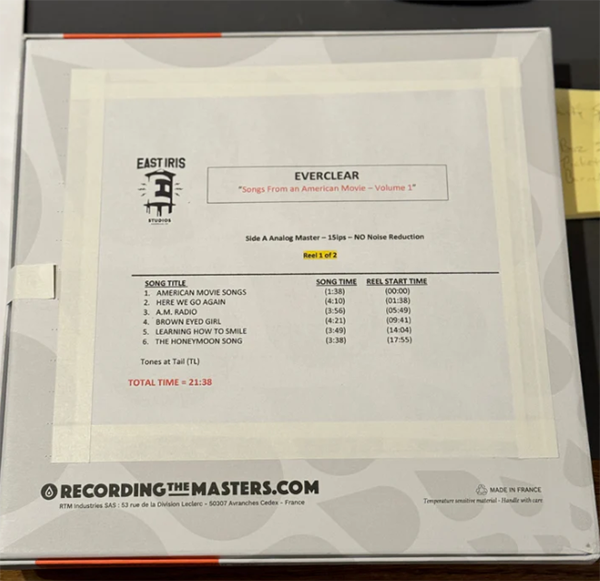
Mike Mettler: I feel like I’m listening to a completely different record, honestly, when I first dropped the needle on Vol. One, because there’s almost no comparison between the analog and the digital. On vinyl, I get so much more out of songs like “AM Radio,” “Wonderful,” and Annabella’s Song.” It’s essentially a completely different listening experience, because I’ve heard these songs a certain way for almost 25 years. But now, I’m getting to hear them probably closer to what your artistic intention was back in the day, wouldn’t you agree?
Art Alexakis: Absolutely. But to be fair, this was the first record I ever did that was recorded on digital. All the other albums had been recorded on tape, so they were AAD, because by the time they went to CDs, it was D. This [SFAAM Vol. One] is the first record I ever did that was DDD. Now, we actually did go to analog tape to mix it, however.
Mettler: And that’s what they found in the vaults, right? Those tapes?
Mettler: Right. We chose them for convenience, like for the times when we’d take long road trips in the car, and would wind up taking along those travel cases with literally hundreds of CDs in them.
Mettler: Oh, that’s great. I love that retro look.
Mettler: Oh yeah, you’ve got to do it first. I have to say, it’s just a beautiful thing to be able to put this record on and hear it the way I think it was intended. The character of your vocal on “AM Radio” just sounds better to me. It fits that song even more by dropping a needle on it than when cueing up the CD, because I can better appreciate the production choices you have on the verses. That’s where it sounds exactly like you’re on the radio, which is obviously what you wanted to do there. I’m sure you had to be very, very hands-on to get that just how you wanted it.
I remember Justin Timberlake, when he was in *NSYNC, we were at this thing in [Las] Vegas onstage giving out awards. Backstage, he’s like, “Man, that record is like the Sgt. Pepper’s of this millennia.” I go, “Get out of here!” But it is a production piece. It’s a very thematic record. That is a divorce record, for sure. Yeah.
Mettler: Yes, well, it’s like two sides of a manifesto, because a lot of times you’re saying, “I don’t want to do this,” or “I want to do that.” Kind of like, “These are the things I shouldn’t have done or don’t want to do, but this is just human beings being human, so I’m going to try and do this instead.” You’re giving yourself your full analysis of, “What did I do wrong? How can I get better?” That’s kind of how I see it.
Mettler: You gotta live life to learn life, right? I think this album is the perfect soundtrack for that particular phase of your life. (Alexakis nods) Now, let’s talk about the production choices you made, like the string section that just gives certain songs here that fuller feel. And especially having “Annabelle’s Song” at the very end of Side 2, where it fits just right. Sequencing-wise, since you were in the CD age at the time, were you still thinking, “If this ever comes out on vinyl, this is the 6 and 6 split I would have had anyway,” or did you have to change any of it?
Mettler: Right — there’s no real break because you’ve got the radio station IDs, or people talking and overlapping voices, and all sorts of cool stuff.
Mettler: Yes, on “The Honeymoon Song” [Side 1, Track 6]. And, relative to the 12-inch frame, an interesting point was made about Vol. One because the photos you used were originally shot for the smaller, CD-case size. You guys had to go back to, who was it, Frank Ockenfels, the original photographer, and get the right imagery so that it would translate to the 12-inch size rather than blowing it up from 5 to 12.
Mettler: I just love the TLC you’ve given this whole package. Did you and Shane talk about the test pressings after you got them? Was there anything you felt like you needed to fix after you heard the first run?
Mettler: Oh, I believe it. I know how meticulous Shane is, because he’ll reject anything himself before going any further with it. Before you got to this stage, did you say anything to him like, “Hey, Shane, I want you to do this when you get the tapes,” or did you even know the tapes in the vault were going to be found? How did Neal Avron, the original engineer, come into the picture?
Mettler: That’s so true. Now, did you personally hear anything on the vinyl that you went, “Oh, I forgot that was there. This sounds better to me” as the artist, or was there something that you maybe didn’t feel you got digitally that comes across better to you on the vinyl?
Mettler: Well, I’d say “guilty” here too, because if I didn’t hear what I wanted out of this pressing, you’d know it. I had high expectations for it based on the two previous Intervention LPs you and Shane did together, so I kind of already knew this was going to be even better. Do you remember what turntable you listened to the test pressings on over at your friend’s house?
Mettler: Nice. Growing up, did you have a turntable that was like your favorite that you kept for years and years, or did you just have to make-do?
I wish I had never sold it, but there was a time when I was going through bankruptcy. I called him and I said, “Do you want this back? Or, if not, I want to sell it — but you gave it to me as a present.” He goes, “Nah, man, do what you want.” And I’m like, “Okay.” I don’t dwell on it. Things happen. You just kind of let it go. I’d like to have it again, but it is what it is. Life happens and, yeah, I don’t dwell on the past stuff like that.
Mettler: I know you gotta roll, so let me ask you this to wrap things up — is there’s one demo track on Vol. One for people to cue up where you’d say, “Hey, if you really want to get how this record sounds on vinyl, the artist suggests you put on track blank.” What’s the one track you’d want people to hear for that purpose?
Mettler: Great choices. “Annabella’s” has live strings on it, right? How did that come about?
Mettler: Wow. Last thing since you have to go is, when does Shane get the tapes for Vol. Two?
Mettler: No? Ahhh, come on!
Mettler: Understood. But would you consider taking the best songs from Vol. Two and just do a compressed, “Art’s Version” and call it Vol 1.5, or something like that? Would that even be a consideration?
EVERCLEAR
Side 1
Side 2
Alexakis: Exactly, exactly. And this hasn’t even been remastered. This is just
Alexakis: Yeah. I mean, that was what it was, back in the day. But these days, it’s all about vinyl. I used to have a really good stereo system for years, but I had to sell it. I just bought a new system through Harman Kardon, and it’s their modern, top-of-the-line JBL stuff in those old, ’70s-looking cases.
Alexakis: Dude — it’s with the big knobs on it. I’ve got a guy coming to tune the room. I’ve got analog speakers for that system, and digital speakers all over the house. The first thing I’m playing on it is going to be this record.
Alexakis: Oh, yeah. I mean, I’m hands on with everything I’ve ever done, but this album specifically — I mean, people ask me what my favorite record is, and I do love all of them. I love all my kids (both laugh), but it [SFAAM Vol. One] actually started as a solo record. It was going to be a lot less rock, a lot more R&B, and with the loops, sampling, and all sorts of stuff that were new at the time. I was having fun playing with all that stuff.
Alexakis: Exactly! I’m a guy who’s been through a lot of marriages (slight pause) . . . and a lot of therapy. (laughs heartily)
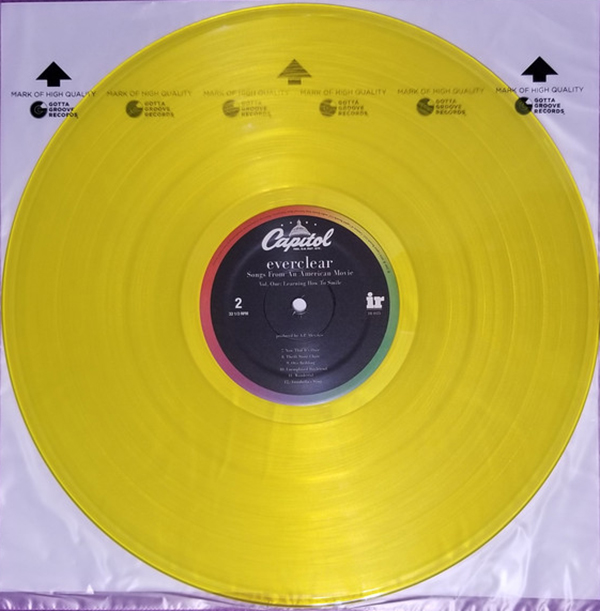
Alexakis: I have always thought in “Side 1” and “Side 2” — always. Always, “How are we going to end Side 1? How are we going to start Side 2?” You know, on a CD, you think of 1 through 12 as opposed to 1 through 6, or 1 through 5 and 6 through 12, or whatever. But I had to think of both, because there’s either music or talking, and there’s digital information between almost every song on this album.
Alexakis: Or the sound of waves.
Alexakis: Yeah, Frank W. Ockenfels III. Frank shot Afterglow, he shot this album, and he shot Songs From an American Movie Vol. Two: Good Time for a Bad Attitude, too. So, yeah — we reached out to him, and he sent us all those files, and didn’t charge us anything. He was always a great guy. I haven’t kept up with him, but man, we always had a great relationship working together, and we were always in sync on stuff.

Alexakis: It sounded good. It sounded like a test pressing, you know? But, yeah, it sounded good. I went over to a friend of mine’s house to listen to them. They send you six copies, and I brought about four of them. We listened to a little bit from each one, and listened to one all the way through. They sounded fine — consistent. Shane’s not gonna send me something that I’m not gonna approve. He never has.
Alexakis: We just asked — Neal submitted for them from Universal, and they sent him the half-inch tapes. They had ’em. So, at least they were able to master from the half-inch, and that was cool. It’s the exact same mastering as before — but mastering to vinyl is different, and Shane uses the guy [Kevin Gray] that really sculpts. He’s really good. Some tolerances will work on digital that won’t work on vinyl, and vice-versa.
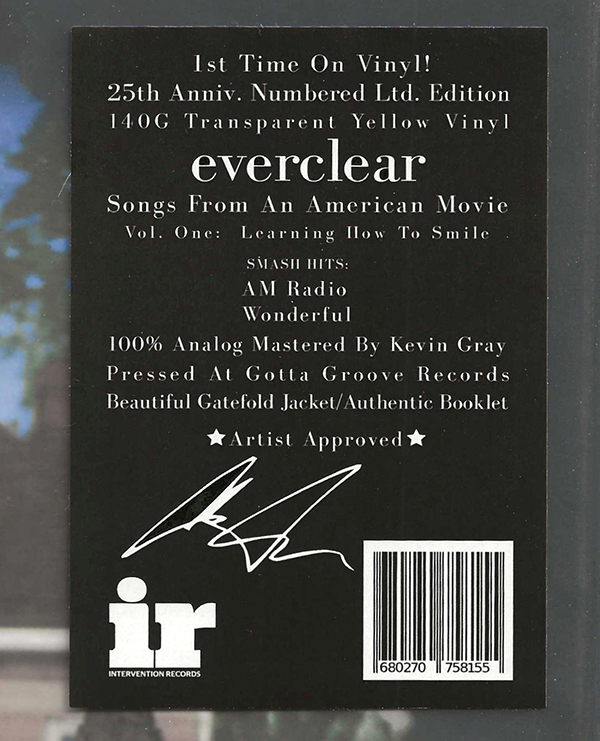
Alexakis: No, it just sounded like vinyl. It sounded closer to how I wanted it to sound, from the beginning. It wasn’t like a huge revelation. It was what I expected to hear. I’ve got pretty high standards of what I wanted to hear — and I heard it. So, yeah.
Alexakis: He’s got vintage stuff, so I think it was an old Technics.
Alexakis: I had to make-do. I got whatever my sisters and brothers handed down to me. When Everclear hit, my second wife — mother of my daughter — my father-in-law, her dad, is an audiophile. For Christmas one year, he gave me a bunch of his used stuff, but we’re talking stuff like Linn amps, and all that — and if you wanted to buy that system now, you’re talking 30, 40 grand, easy. The turntable was Technics, and it was just phenomenal. Vinyl sounded killer on that system.
Alexakis: I would say two songs. “Learning How to Smile” [Side 1, Track 5], which is one of my favorite songs I’ve ever written, and also “Annabella’s Song” [Side 2, Track 6 (even though it’s listed there as Track 12, per the original numbering)].
Alexakis: Yeah. Dude, we had a 24-piece orchestra come in, downstairs in the Capitol building [in West Hollywood], and I’m singing in the booth where [Frank] Sinatra and Mel Tormé used to sing.

Alexakis: (chuckles) I don’t know. That’s not going to happen.
Alexakis: No. It didn’t sell very well, man, but I don’t think we would — well, I don’t know. The thing is, that second record [Songs From an American Movie Vol. Two: Good Time for a Bad Attitude, released on CD by Capitol in November 2000] is not one of my favorites. It sounds tired to me, because, originally, I wanted to make a double album with about 18 to 20 songs, instead of two albums of 25 songs. At the time, I didn’t feel like it was filler — but looking back on it, I feel like I could have streamlined it and made just a really killer double album. I was talked out of it by my manager, because managers get paid. (MM laughs) It’s just, if we did it as two albums, we’d get out of our deal with our publishing and with Capitol, and they’d have to renegotiate.
Alexakis: I’ve thought about it. (slight pause) I’ve thought about it, yeah. Well, if Shane comes to me and really wants to do it, then we’ll talk about it.

SONGS FROM AN AMERICAN MOVIE VOL. ONE:
LEARNING HOW TO SMILE
140g 1LP (Intervention/Capitol)
1. Songs From An American Movie Pt. 1
2. Here We Go Again
3. AM Radio
4. Brown Eyed Girl
5. Learning How To Smile
6. The Honeymoon Song
1. Now That It’s Over
2. Thrift Store Chair
3. Otis Redding
4. Unemployed Boyfriend
5. Wonderful
6. Annabella’s Song
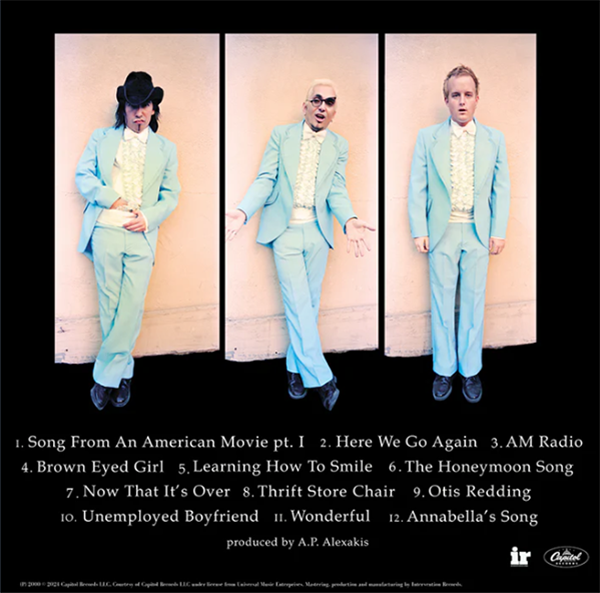
- Log in or register to post comments
















